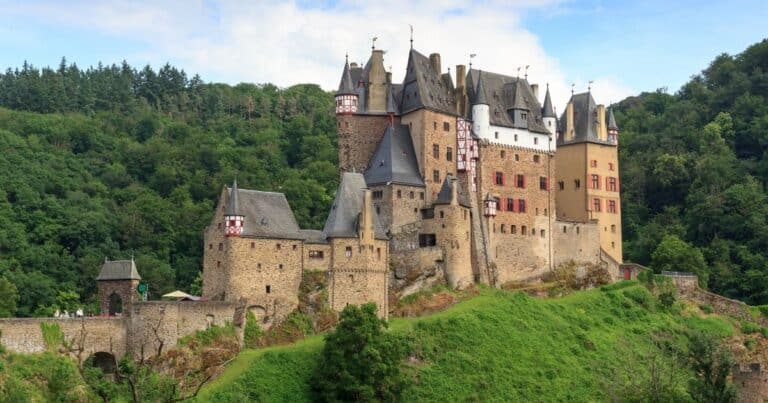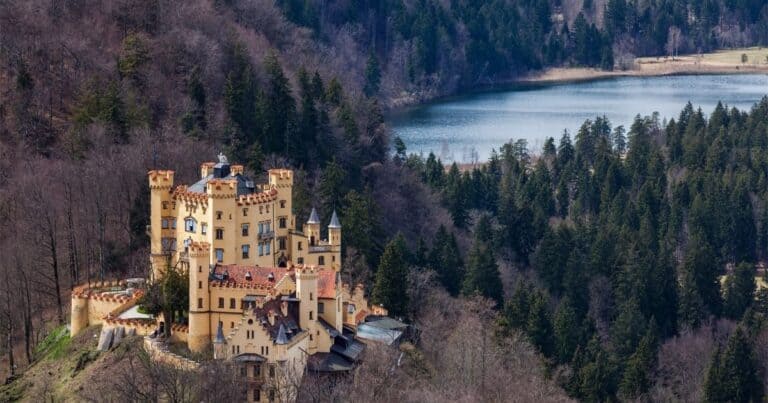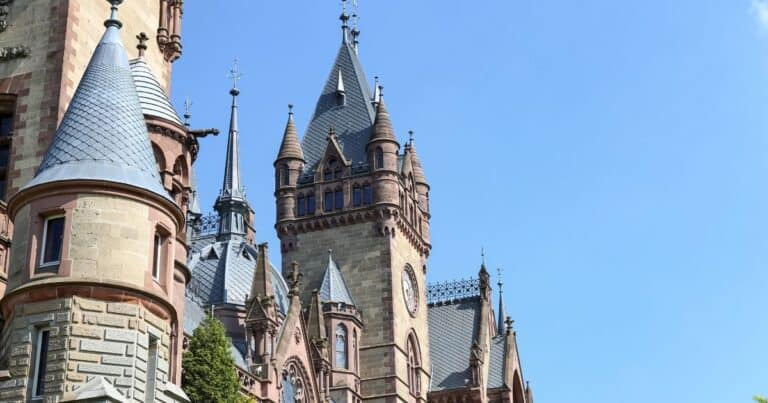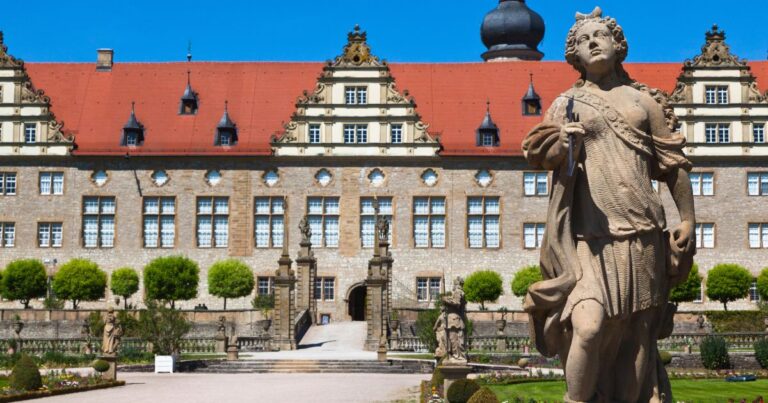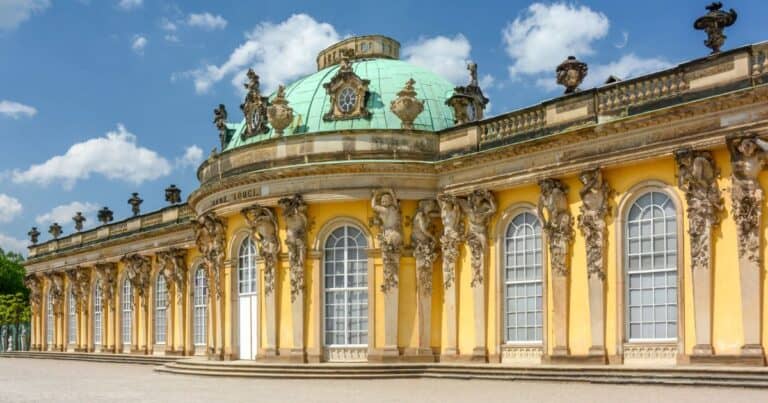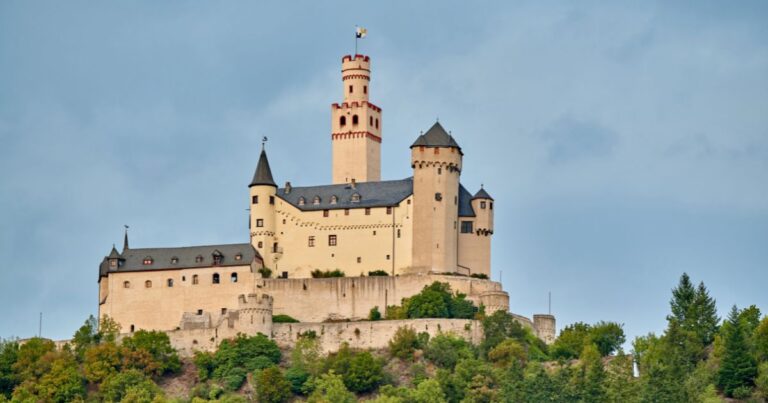Schloss Linderhof: Ludwig II’s Opulent Bavarian Fantasy
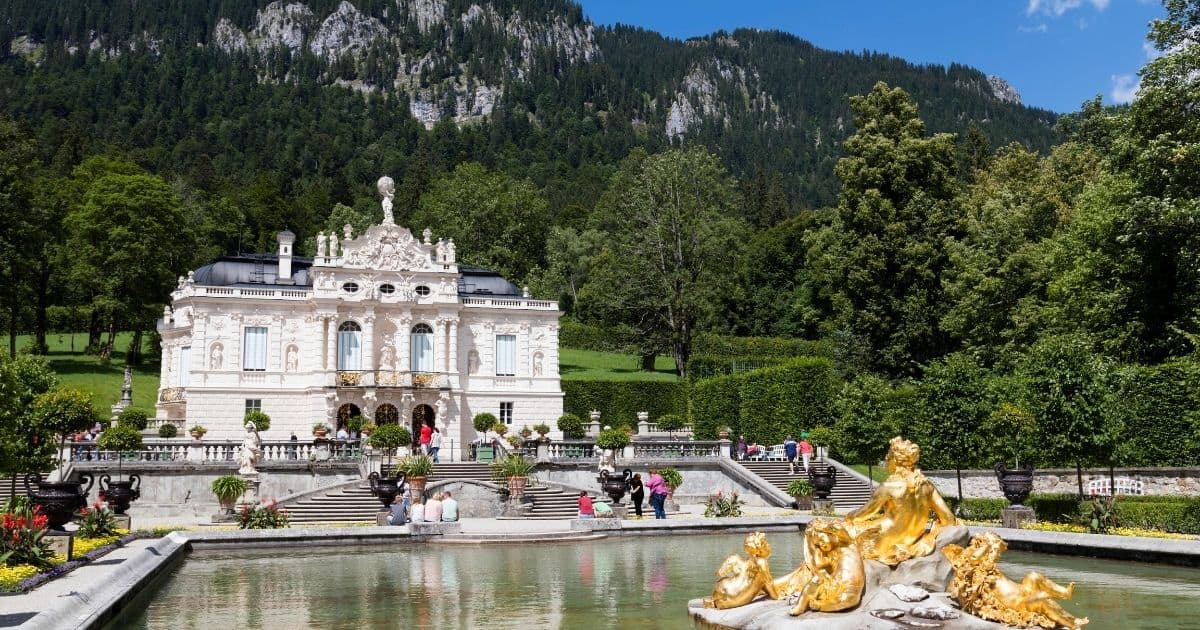
Welcome to Schloss Linderhof, also known as Linderhof Palace, a stunning Bavarian castle that served as the opulent retreat of King Ludwig II. With its breathtaking architecture and picturesque gardens, this historic landmark is a must-visit for anyone interested in German history and culture. Join me as we explore the rich history, architectural marvels, and historical significance of Schloss Linderhof.
Key Takeaways:
- Schloss Linderhof is a Bavarian castle and royal residence that was the opulent retreat of King Ludwig II.
- The palace is known for its stunning architecture and picturesque gardens.
- Schloss Linderhof is a prime example of German architecture and is a popular tourist attraction.
- It holds great historical significance as one of the royal residences of King Ludwig II and offers a glimpse into his lavish lifestyle.
- Visitors can explore the palace’s opulent interior, stroll through the gardens, and admire the unique architectural features.
History of Schloss Linderhof
Schloss Linderhof, also known as Linderhof Palace, has a fascinating history that dates back to the 19th century. This Bavarian castle was commissioned by King Ludwig II, a renowned patron of grand and extravagant architecture.
The construction of Schloss Linderhof began in the 1860s and continued until the untimely death of King Ludwig II in 1886. During this time, the king made numerous changes to the original design, resulting in the creation of a small yet opulent palace that perfectly reflected his royal taste.
Despite his demise, Schloss Linderhof was mostly completed by 1876 and became a cherished royal residence. Today, it stands as a historic landmark, offering visitors a glimpse into the opulent world of King Ludwig II and the Bavarian kingdom.
To truly appreciate the historical significance of Schloss Linderhof, it is essential to understand the vision and aspirations of King Ludwig II. His passion for architectural excellence and his desire to create magnificent spaces made this Bavarian castle a true masterpiece.
Construction Timeline
| Year | Event |
|---|---|
| 1869 | Construction begins on Schloss Linderhof |
| 1870 | King Ludwig II died, leaving Schloss Linderhof as a testament to his legacy |
| 1874 | Major renovations and expansions are carried out |
| 1876 | Most of the construction on Schloss Linderhof is completed |
| 1886 | King Ludwig II dies, leaving Schloss Linderhof as a testament to his legacy |
Throughout its construction, Schloss Linderhof underwent significant modifications and additions, reflecting King Ludwig II’s evolving vision. The end result is a unique palace that harmoniously combines different architectural styles, making it a true representation of the king’s opulent fantasies.
Explore the captivating history of Schloss Linderhof and discover the architectural marvels that make it a renowned historic landmark.
Architecture of Schloss Linderhof
Schloss Linderhof, also known as Linderhof Palace, is renowned for its exquisite architectural design. The palace seamlessly combines elements of Renaissance, Baroque, and Rococo styles, resulting in a truly unique masterpiece. Both the exterior and interior of the palace showcase superb craftsmanship and attention to detail.
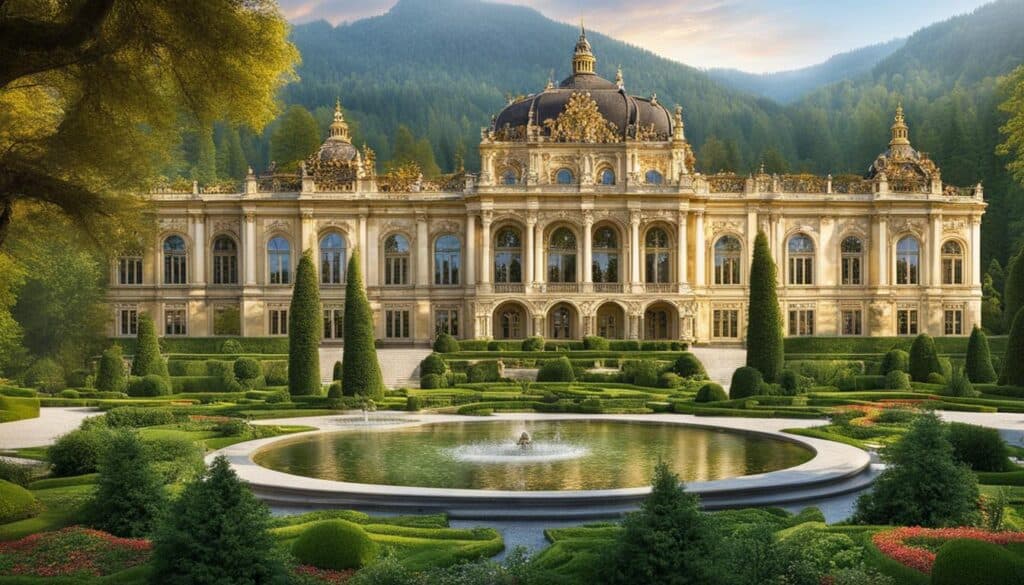
The Exterior
The exterior of Schloss Linderhof features ornate facades adorned with intricate detailing. Elaborate sculptures, majestic columns, and decorative motifs enhance the palatial charm of the structure. The palace’s modest proportions do not diminish its impact; instead, they emphasize the beauty and elegance of the architecture.
The Interior
Step inside Schloss Linderhof, and you’ll be mesmerized by the opulent decorations and rich guild work. Every room exudes luxury and grandeur, with lavish furnishing and meticulously crafted elements. The palace’s interiors are a testament to King Ludwig II’s desire to create a fantasy world, reminiscent of the renowned Palace of Versailles.
Meticulous Craftsmanship
The architectural design of Schloss Linderhof showcases exceptional craftsmanship. From the intricately carved woodwork to the meticulously painted ceilings, every detail reflects the dedication and skill of the artisans involved. The palace is a testament to the rich tradition of German architecture and serves as a source of inspiration for architects and enthusiasts around the world.
| Architectural Features | Description |
|---|---|
| Renaissance Influences | The palace exhibits Renaissance-inspired elements, such as symmetrical layouts and arched windows, which contribute to its classic elegance. |
| Baroque Elements | Ornate decorations, elaborate frescoes, and grand staircase showcase the opulence associated with the Baroque style. |
| Rococo Finishes | The palace’s interior features Rococo-style finishes, characterized by soft curves, floral motifs, and delicate embellishments. |
| Exquisite Gardens | The meticulously designed gardens surrounding the palace complement its architectural beauty, creating a harmonious and enchanting atmosphere. |
The architectural brilliance of Schloss Linderhof is a testament to the vision of King Ludwig II and the mastery of the craftsmen involved. It stands as a proud symbol of German architecture, inviting visitors to immerse themselves in its grandeur and marvel at its meticulous craftsmanship.
Historical Significance of Schloss Linderhof
Schloss Linderhof, also known as Linderhof Palace, holds great historical significance as one of the royal residences of King Ludwig II, a prominent figure in German history. As a private retreat for the king, away from the pressures of royal duties and the outside world, Schloss Linderhof offers a unique insight into the life and opulence of one of Germany’s most famous monarchs.
During his time at Schloss Linderhof, King Ludwig II had the freedom to indulge in his fantasies and immerse himself in a world of luxury and beauty. The palace served as a haven where he could escape from the demands of his royal responsibilities and create his own enchanting universe.
Today, Schloss Linderhof stands as a testament to the legacy of King Ludwig II and is a symbol of not only his personal taste but also Bavarian history and culture. Its historical significance lies in its representation of the royal lifestyle during Ludwig II’s reign, showcasing the grandeur and extravagance associated with the monarchy.
The Opulence of Schloss Linderhof
The opulent interiors, adorned with intricate decorations and ornate guild work, reflect the king’s lavish taste and attention to detail. The palace’s distinctive architectural features and exquisite craftsmanship are a testament to the skill and artistry of the craftsmen involved in its creation.
Table: Schloss Linderhof – Key Historical Features
| Feature | Description |
|---|---|
| Opulent Interiors | The palace’s interiors boast rich decorations and intricate guild work, showcasing King Ludwig II’s extravagant taste. |
| Architectural Significance | Schloss Linderhof represents a unique blend of architectural styles, including Renaissance, Baroque, and Rococo. |
| Palace Gardens | The picturesque gardens surrounding the palace add to its historical significance and offer a serene escape. |
| Private Retreat | Schloss Linderhof served as a private sanctuary where King Ludwig II could retreat from royal duties and indulge in his fantasies. |
The historical significance of Schloss Linderhof extends beyond its association with King Ludwig II. Its status as a historic landmark preserves the memory of Bavarian royalty and offers visitors a glimpse into the past. Exploring the palace and its grounds provides a unique cultural and historical experience, allowing visitors to immerse themselves in the opulence and elegance of a bygone era.
Next, in Section 5, we will provide a comprehensive visitor guide for those planning a visit to Schloss Linderhof, including tips on how to make the most of your trip and neighboring attractions to explore.
Visitor Guide to Schloss Linderhof
Welcome to Schloss Linderhof, a magnificent tourist attraction nestled in the Ammer Valley near Oberammergau and the town of Ettal. As a Bavarian castle renowned for its picturesque gardens and German architecture, Schloss Linderhof invites visitors from all around the world to revel in its grandeur and beauty.
When planning your visit, you’ll find that Schloss Linderhof is easily accessible by car or public transportation, with convenient on-site parking available. Before embarking on your journey, it’s advisable to check the palace’s operating hours to ensure a seamless and enjoyable visit.
The spring and summer months are the perfect time to explore Schloss Linderhof, as the gardens are in full bloom, offering breathtaking sights and fragrant blooms. Within the palace’s opulent interior, you will discover a world of luxury and elegance, with ornate decorations and rich guild work that reflect the lavish taste of King Ludwig II.
To enhance your experience, take leisurely strolls through the meticulously manicured gardens, where you can immerse yourself in nature’s beauty and find solace amidst the tranquility. Marvel at the unique architectural features that make Schloss Linderhof a true gem of German architecture, lending unmatched charm and allure to this Bavarian castle.
While exploring Schloss Linderhof, don’t miss the opportunity to visit nearby attractions such as the world-famous Neuschwanstein Castle and the charming town of Oberammergau. These destinations offer additional opportunities for exploration and sightseeing, allowing you to delve deeper into the rich history and culture of the region.
For those wishing to prolong their visit, accommodations are readily available in the vicinity of Schloss Linderhof. Whether you prefer a cozy inn, a luxury hotel, or a charming bed and breakfast, you’ll find a variety of options to suit your preferences and ensure a comfortable stay.
Experience the enchantment of Schloss Linderhof and create lasting memories as you indulge in the splendor of this Bavarian castle, surrounded by picturesque gardens and steeped in the rich heritage of German architecture.
Visitor Guide to Schloss Linderhof Summary:
| Key Information | Details |
|---|---|
| Location | Ammer Valley near Oberammergau and Ettal |
| Access | Car or public transportation |
| Parking | Available on-site |
| Operating Hours | Check before your visit |
| Best Time to Visit | Spring and summer months |
| Main Highlights | Opulent interior, picturesque gardens, unique architectural features |
| Nearby Attractions | Neuschwanstein Castle, Oberammergau |
| Accommodations | Available in the vicinity |
Highlights of Schloss Linderhof
Schloss Linderhof, a renowned Bavarian castle and popular tourist attraction, offers a multitude of key attractions that make it an absolute must-visit destination. From the moment you step inside, the opulent interior of Linderhof Palace will captivate your senses. Intricate guild work and ornate decorations adorn every corner, transporting you to a world of royal luxury.
As you explore the palace grounds, you’ll be met with the breathtaking beauty of the picturesque gardens. The meticulously manicured lawns and vibrant flower beds provide the perfect backdrop for leisurely walks and idyllic picnics.
One of the most enchanting features of Schloss Linderhof is the Venus Grotto, inspired by Wagner’s opera Tannhäuser. Step inside and be immersed in a mesmerizing underground world, complete with artificial waterfalls and ethereal lighting.
The palace grounds also boast two architectural marvels that add a touch of exoticism to the surroundings. The Moorish Pavilion and the Moroccan House, both acquired by King Ludwig II, showcase intricate designs and unique cultural elements.
Overall, a visit to Schloss Linderhof promises a truly unforgettable experience. Immerse yourself in the grandeur of the palace’s interior, stroll through the picturesque gardens, and marvel at the enchanting Venus Grotto and other architectural gems. Schloss Linderhof is a testament to the timeless beauty and allure of Bavarian castles.
Nearby Attractions and Accommodations
Schloss Linderhof is surrounded by a wealth of attractions and offers easy access to other notable destinations in Bavaria. One of the must-visit attractions near Schloss Linderhof is the iconic Neuschwanstein Castle, another Bavarian castle that draws visitors from around the world. Neuschwanstein Castle is known for its fairy-tale architecture and stunning views, making it a perfect complement to a visit to Schloss Linderhof.
The nearby towns of Oberammergau and Ettal also offer a range of attractions and charming accommodations for those wishing to stay in the area. Oberammergau is famous for its Passion Play, which attracts visitors every ten years, as well as its traditional woodcarving and charming Alpine scenery. Ettal, on the other hand, is known for its beautiful abbey, historic brewery, and peaceful surroundings.
These towns provide a perfect base for further exploration of the Bavarian countryside, offering opportunities for hiking, cycling, and enjoying the stunning natural beauty of the region. Visitors can also indulge in local cuisine and experience the warm Bavarian hospitality in the numerous restaurants, cafes, and hotels in the area.
Whether you’re interested in exploring more castles, immersing yourself in nature, or experiencing local culture, there is something for everyone near Schloss Linderhof.
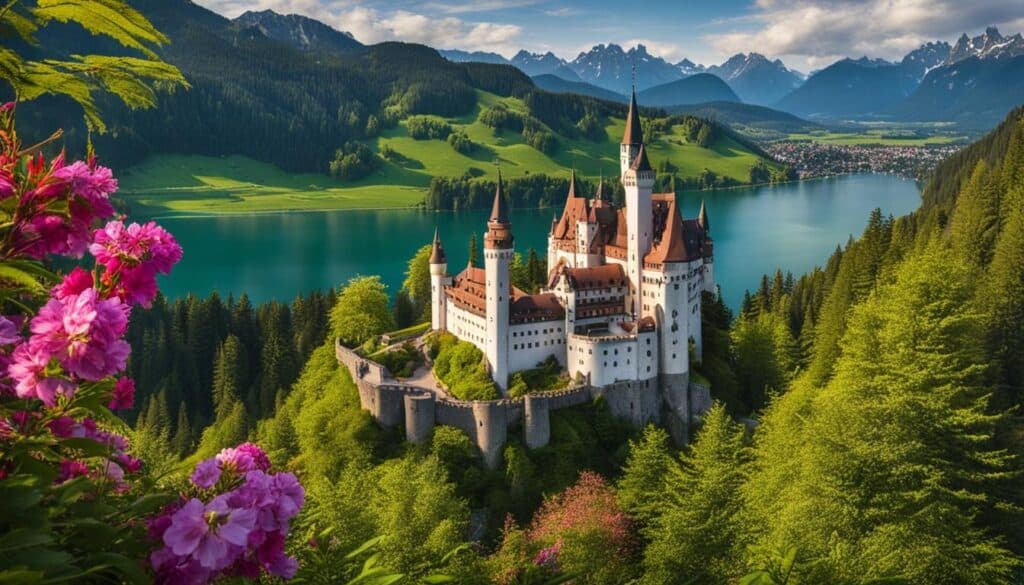
Notable Nearby Attractions:
- Neuschwanstein Castle
- Oberammergau
- Ettal Abbey and Brewery
- Alpine Scenery
Where to Stay Nearby:
| Town | Accommodation Options |
|---|---|
| Oberammergau | Hotels, Guesthouses, Vacation Rentals |
| Ettal | Hotels, Guesthouses |
Conclusion
Schloss Linderhof, also known as Linderhof Palace, is a true gem of Bavaria that showcases the opulent world of King Ludwig II. With its stunning architecture, picturesque gardens, and rich historical significance, it is a must-visit destination for anyone interested in German history and culture. Whether you’re a fan of royal palaces, architectural marvels, or simply enjoy immersing yourself in the beauty of nature, Schloss Linderhof has something for everyone.
The palace’s lavish interior and meticulously crafted exteriors leave a lasting impression on all who visit. As one of the most famous landmarks in Germany, Schloss Linderhof offers a glimpse into King Ludwig II’s extravagant lifestyle and his vision of a fairytale-like retreat. Visitors can explore the palace’s ornate rooms, stroll through the scenic gardens, and marvel at the unique blend of architectural styles.
Located near other notable attractions such as Neuschwanstein Castle, Schloss Linderhof is an ideal starting point for immersing yourself in the rich history and breathtaking beauty of Bavaria. Whether you’re a history enthusiast, an architecture lover, or simply looking for a memorable experience, Schloss Linderhof should be at the top of your list when exploring this fascinating region.
FAQ
When was Schloss Linderhof built?
Schloss Linderhof was built in the 19th century.
Who commissioned the construction of Schloss Linderhof?
Schloss Linderhof was commissioned by King Ludwig II.
What architectural styles are showcased in Schloss Linderhof?
Schloss Linderhof incorporates Renaissance, Baroque, and Rococo architectural styles.
What is the historical significance of Schloss Linderhof?
Schloss Linderhof served as one of the royal residences of King Ludwig II.
How can I reach Schloss Linderhof?
Schloss Linderhof is located in the Ammer Valley near Oberammergau and the town of Ettal. It can be reached by car or public transportation.
What are the highlights of a visit to Schloss Linderhof?
The highlights of a visit to Schloss Linderhof include exploring the opulent interior, strolling through the picturesque gardens, and marveling at the unique architectural features.
What nearby attractions and accommodations are available?
Nearby attractions include Neuschwanstein Castle and the towns of Oberammergau and Ettal. There are accommodations available in these towns for visitors.

